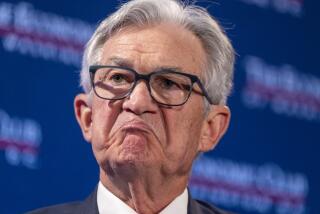A Man of Influence: THE EXTRAORDINARY CAREER OF S. G. WARBURG by Jacques Attali (Adler & Adler: $22.50; 444 pp.)
- Share via
This is a biography of one of the great merchant bankers of our generation, Siegmund Warburg. The author, Jacques Attali, is, at age 42, the closest adviser of France’s president, Francois Mitterrand. Attali obviously admires Warburg greatly, calling him “the prince of finance, the adventurer of the century.”
The Warburgs are a Sephardic Jewish family which settled in northern Germany in the early 16th Century. They were moneychangers, first in the town of Warburg, from which they took their name, and then Hamburg. But it was not until the second half of the 19th Century that they rose to national prominence as financial advisers to the Kaiser, and later as a result of the very substantial way in which they supported the Weimar Republic. For it was the banking house M. M. Warburg that took the lead in arranging loans to Germany from the United States in the 1920s, loans that enabled that country to at least partially meet its reparation payments, and recover economically from the war.
When the Nazis took power, both Hjalmar Schacht, who was to become the financial and economic czar of the Third Reich, and Baron Constantin von Neurath, Hitler’s first foreign minister, continued to seek the Warburgs’ advice, at least initially. But in 1933, the latter advised Siegmund, then 30 years old, to get out: The Warburgs, as Jews, were finished in Germany. He first went to New York where many members of the Warburg family lived (including Paul Warburg, one of the founders of the Federal Reserve system), but then decided that his future lay in Europe. He moved to England, where he established his own merchant banking operation in 1934 in association with a small group of fellow emigres, all German or Austrian Jews.
It was not until 1956, however, that Siegmund Warburg began to make his mark. In that year, he arranged for the first postwar, long-term, European loan in dollars to be placed in New York. It was for the European Coal and Steel Community. Shortly thereafter, he engineered the first hostile takeover of a major British firm, British Aluminium, by a foreign company, Reynolds Aluminum. And in 1963, he invented the Eurodollar bond, arranging for a dollar bond issue designed to help finance the Autostrade Italiane to be placed in Europe. In other words, he was using offshore dollars to finance an offshore loan. As logical as this seems today, up until that time, all international dollar bonds had been issued in New York, and been purchased with domestic U.S. dollars.
What this eventually led to was a new capital market of immense proportions. According to the author, “In all, within twenty years 3,740 such Euro-issues were floated, totaling $186 billion. S. G. Warburg as the lead bank had placed nearly one-third, that is 906, totaling $60 billion.” This was made possible as a result of the development of cooperation between the world’s most powerful bankers, a unique network that included Hermann Abs of the Deutsche Bank, Hans Schaefer of the Union Bank of Switzerland, Marcus Wallenberg of Stockholm’s Enskilda Bank, David Rockefeller of Chase Manhattan. Siegmund was recognized as the primus inter pares by this group, which made him “one of the greatest seers of world capitalism of the time.”
I met Siegmund Warburg in the early 1960s in his offices on Gresham Street in London where I sought out his advice in regard to an investment situation in England with which I had become involved. I remember him treating me, a 29-year-old rather naive American, with enormous patience and true Old World courtesy. Because of the very power of his presence, it is a memory that remains vivid to this day.
Jacques Attali’s portrait of S. G. Warburg, who died in 1982, is likewise a vivid one. The only problem with his book is that before he gets to Siegmund Warburg, the author spends the first 166 pages retelling the diplomatic and financial history of Europe since the 16th Century, with occasional forced references to the role of the Warburg family. The history gets a B, the telling thereof a C-. After that, however, “A Man of Influence” really takes off. When you are done reading it, you cannot help but agree with Attali’s conclusion, as stated in the final sentence of this book: “It could be said that Siegmund Warburg was the best that Europe and the Jewish people have given our time.”
More to Read
Sign up for our Book Club newsletter
Get the latest news, events and more from the Los Angeles Times Book Club, and help us get L.A. reading and talking.
You may occasionally receive promotional content from the Los Angeles Times.








